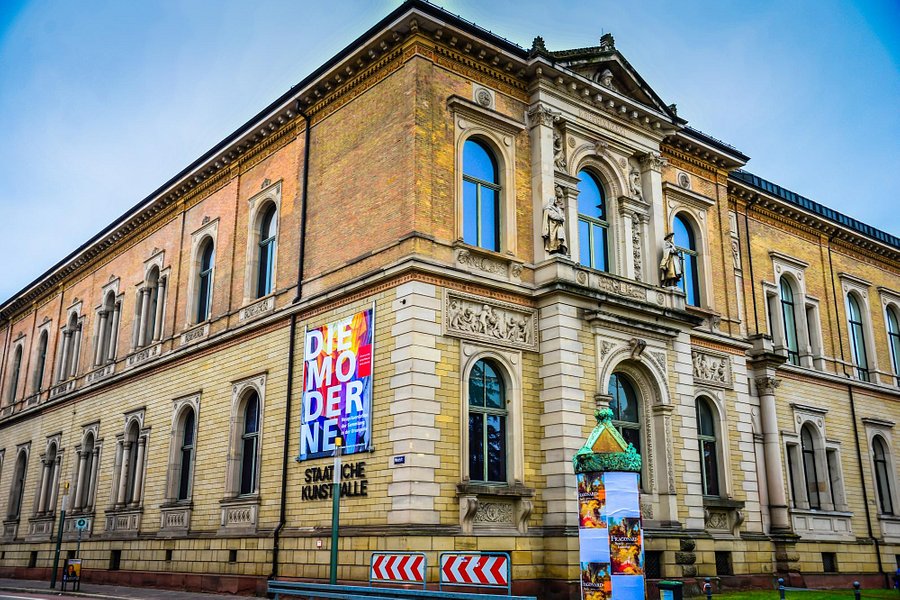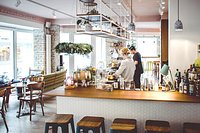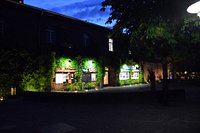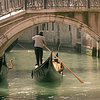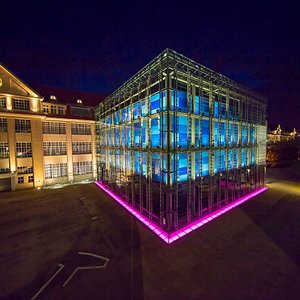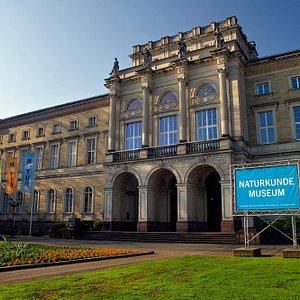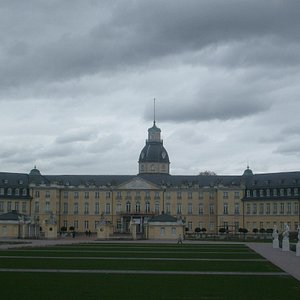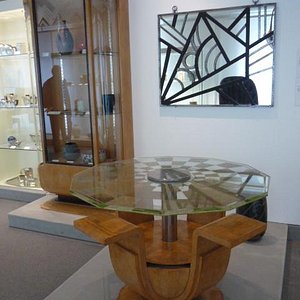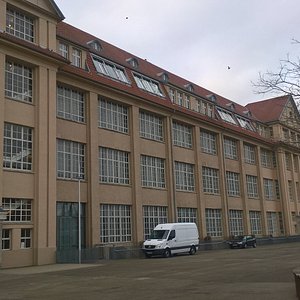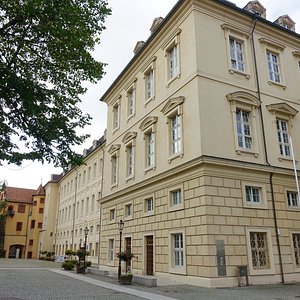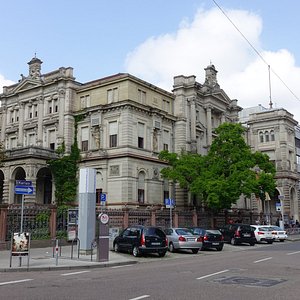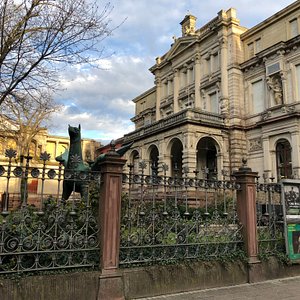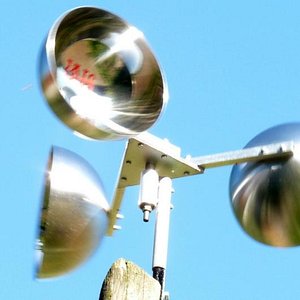Staatliche Kunsthalle Karlsruhe
Staatliche Kunsthalle Karlsruhe
4.5
11:00 AM - 6:00 PM
Wednesday
10:00 AM - 6:00 PM
Thursday
10:00 AM - 6:00 PM
Friday
10:00 AM - 6:00 PM
Saturday
11:00 AM - 6:00 PM
Sunday
11:00 AM - 6:00 PM
About
The Kunsthalle Karlsruhe was one of the first museum buildings in Germany and is one of the very few to have largely retained its original design. After the Kunsthalle’s closure for extensive renovation work in November 2021, at last, they can be seen again for the first time: The highlights of the Kunsthalle collection from the late Middle Ages to the present will be presented on around 2000 m² at ZKM | Center for Art and Media.
Duration: 2-3 hours
Suggest edits to improve what we show.
Improve this listingFull view







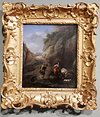
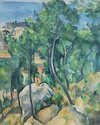
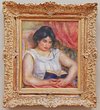
Top ways to experience nearby attractions
The area
Address
Neighborhood: Innenstadt-West
Reach out directly
Best nearby
Restaurants
648 within 3 miles
Attractions
79 within 6 miles
Contribute
Most Recent: Reviews ordered by most recent publish date in descending order.
Detailed Reviews: Reviews ordered by recency and descriptiveness of user-identified themes such as wait time, length of visit, general tips, and location information.
4.5
112 reviews
Excellent
59
Very good
33
Average
14
Poor
1
Terrible
5
dnvpaul
Kew Gardens, NY271 contributions
Feb 2012 • Solo
Unlike an art museum in a larger city, you will not find big blockbuster exhibitions in The Kunsthalle, but it is for precisely this reason it is worth a visit. It is rarely crowded and one can better appreciate the collection. The building itself is worth seeing, with a lovely grand staircase. I have been to several special exhibits here and I was impressed at the presentation. The permanent collection has some interesting German works one doesn't see often. The print/engraving room is intriguing.
Written March 8, 2012
This review is the subjective opinion of a Tripadvisor member and not of Tripadvisor LLC. Tripadvisor performs checks on reviews as part of our industry-leading trust & safety standards. Read our transparency report to learn more.
magistros
Glyfada, Greece1,728 contributions
Oct 2020
great place to spend couple hours, they have good selection of paintings some very well know Cezane, Delacroix, Pisarro, Renoir.
Written November 4, 2020
This review is the subjective opinion of a Tripadvisor member and not of Tripadvisor LLC. Tripadvisor performs checks on reviews as part of our industry-leading trust & safety standards. Read our transparency report to learn more.
periandro
Luxembourg City, Luxembourg7,839 contributions
Sep 2018
The Karlsruhe Staatliche Kunsthalle is an important museum in Germany which houses plenty of works of art some of which constitute real masterpieces. Works having stemmed from worldwide famous brushes, such as Canaletto, Rembrant, Kalf and Metsu can be contemplated in that gallery; a real enjoyment producing enrichment on a spiritual level at the sight of so many marvels is therefore assured. The sight of the main façade with its imposing three-arched entrance portal and the three windows above it on the balustrade as well as the pediment is in itself a stunning view. The Kunsthalle can be considered in general as a sublime edifice being therefore fitted for the artistic masterworks it houses tending to immortality. In line with that the spatial impression one gets upon entering the entrance hall is comparable to that one may receive upon entering an Italian gothic cathedral. Besides, the spatial impact of the lower floor is especially ascribable to its impressive height. Notwithstanding that, upon leaving behind the two flights of stairs the upper floor appears as a wide, gently vaulted space with four doors and a high window letting much light penetrate.
The origin of the Karlsruhe Staatliche Kunsthalle dates back from the sixteenth century. The original designs were made by the architect Heinrich Hübsch (1795-1863), the first ones dating from the year 1835 upon Grand Duke Leopold Baden's decision to redesign the old academy building and erect the “New Academy Building”.
The frescoes in some of the interior walls of the grand duke's Kunsthalle are the work of Moritz von Schwind (1804-1871). The decoration of the stairwell depicts the consecration of Freiburg cathedral by Duke Berthold, the Zähringer, illustrated in life figures. The two outer frescoes illustrate “Imagination” and “Mathematics” as prerequisites for architecture. The main decorative fresco is a magnificent work representing almost seven hundred years of Baden history. All such frescoes are very impressive. The feeling one has at their sight is that of entering a fabulous realm of vibrant culture.
The large fields and friezes in the groundfloor bear appropriate historical compositions, such as scenes from the Olympic Games from Iliad. They are fantastic works. At the sight of the “Philostratic Paintings” in the current presentation hall one certainly feels thrilled. The interest for this subject among 19th century artists was due in part to Johan Wolfgang von Goethe's essay “Philostratus's Paintings, Ancient and Moderns”. The set of thirty eight panels is organised in seven thematic areas as per Gorthe's stipulation and images concerning death and mourning.
In the third pink-coloured hall one can observe references to two myths about founding of Rome, one of them consists in Aeneas, founder of Rome, disembarking at Cunae and his marriage to Lavinia, daughter of King Latinus. As regards the second founding myth there is the image of a shewolf feeding Romulus and Remus, and another panel illustrates the rape of the Sabine women. A careful observation of those works is indeed recommendable.
In the Museum subject matter of this review it's possible to behold superb works of art as far as both painting and sculpture is concerned. Within the first mentioned artistic branch there are manifold masterpieces appertaining to different historical times and styles, from the early German gothic paintings to the divers trends of the twentieth century.
In relation to the late gothic paintings one can admire, for instance, a diptych in its original frame made at Emperor Charles V's court in Prague around the middle of the fourteenth century. It shows on the two panels respectively the touching confrontation of the beginning and the end of Christ's life. The left panel depicts Mary with the Child in an unusually intimate posture. The right panel shows Jesus as a “Man of Sorrows” suspended betwixt death and resurrection. “Christ as Man of Sorrows” showing the Saviour with the crown of thorns and the accoutrements of suffering is the approach of the young Albrecht Dürer to the Passion subject.
Apart from the passion theme, another important motiv of gothic painting is about depictions of the Virgin Mother and of the life of Mary. An example thereof is the work by the Master of the Lichtenthal's Marian panel. On the front and back the Birth of Mary, the Annunciation, the Visitation and Mary's death are represented. Lucas Cranach the Elder's (1472 – 1553) depiction of the Madonna shows a youthful innocence and beauty. Cranach's small lime wood panel of the “Madonna with Child” is among the most charming works in the Kunsthalle.
In relation to secular panel painting belonging to the same epoch as those just mentioned an original and eye catching painting is “Melancholy in the Garden of Life” by Matthias Gerung (1500 – 1568/70). In it, the figure of the lady representing Melancholy appears sitting at the center of a wide world landscape divided in small parcels. The four seasons are represented simultaneously, war and peace coexist and new half-timbered buildings are being constructed next to the collapsing and burning fortifications.
As fine examples of baroque and rococo in Germany one can find, among the most prominent representatives of these styles, influenced no doubt by tendencies from Italy, works by Johann König (1586 – 1642), Johann Liss (1597 – 1629/30) and Johann Heinrich Schönfeld (1609 – 1682/83). König’s painting “Landscape with Tobias and the Angel” is beautifully executed on a small copper plate.
One of the most interesting works in this section is the “Views of Dresden from the Bridgehead of the New Town” by Bernardo Belotto, known as Canaletto (1720 – 1780). In that painting an imposing view of baroque Dresden opens along the Augustus Bridge and over the Elbe. Anton Raphael Mengs (1728 – 1779) had also been court painter in Dresden. His “Portrait of Minister of State Baron Wilhelm von Edelstein” is a marvellous example of his portraiture.
As far as Dutch painting in the sixteenth century is concerned, in the Museum in question one may find a number of excellent examples of religious paintings. Apart from that Quentin Massys (c. 1465 – 1530) and Jan Vermeyen (1500 – 1559) painted gentlemen whose identities are unknown. The one portrayed in Vermeyen's painting which is observable in the Kunsthalle looks straight to the viewer making gesture of appeal. Jan Sanders van Hemessen's (c. 1500 – after 1563) “Loose company” is a very special picture. Painted in 1540, it shows a place looking like a brothel
As regards the Flemish artist having been active in the 17th century there are four works by Peter Paul Rubens (1577 – 1640) in the Kunsthalle. The oldest among them is his portrait of the 22 year old Marchesa Veronica Spinola Doria, which was painted while the painter was still in Italy. It's a precious painting in which Veronica Spinola, a Genovese aristocrat , is presented in a monumental scene. Another great Flemish painter such as Jacob Jordaens made a bold composition picture also housed in the Kunsthalle. It’s his “Moses Strikes Water from the Stone”.
An outstanding position occupies among the Dutch painters of the 17th century Rembrant Harmenszoon van Rijn's. In the collection of the Museum there is his self-portrait. He looks at the visitors with a melancholy, searching, vulnerable and thoughtful expression. Works by other Dutch painters included in that group are also in the Museum being examined. Some of such artists are Clara Peeters, Pieter Claeszoon and Willem Claeszoon Heda as well as Willem Kalf (1619 – 1693 whose “Still Life with Lemon, Oranges and Filled Römer” (1663 – 1664) shows his brilliant artistic reflection of the world of objects.
Items regarding the Dutch genre painting of the 17th century can also be observed in the Kunsthalle. As far as landscape is concerned the painting by Jacob van Ruisdael (1628 – 1682) “Tall Trees by the Water” must be considered as one of the best in that genre out of all those housed in the Kunsthalle. That by Aelbert Cuyp “River Landscapewith Milkmaid” is likewise a beautiful picture.
The Museum section concerning 17th to 19th centuries French paintings ranks among the most comprehensive and valuable collections of this kind in Germany. The Kunsthalle today possesses first class works of baroque, rococo, clsssicist and 19th century art. By Frans Pourbus the Yunger (1569 – 1622) two works in that Museum deserve admiration, i.e. that of the 15 year-old Louis XIII (1601 – 1643), son of Henry IV and Maria de Medici, and the portrait of Elizabeth of France. The creative work by Antoine (c. 1588 – 1648), Louis (c. 1593 – 1648), and Matthieu (1607 – 1677) Le Nain “Preparation for the Dance Class” makes those painters be among the most successful ones of their time. François Boucher’s (1703 – 1770) “Shepherd and Shepherdess” shows gender and affectionate emotions.
Already in the 19th century, landscape became the main subject of the French progressive painters. As a prelude of that trend one can see in the pertinent section of the Kunsthalle the “Rocky Valley at Cività Castellana” by Camille Carot (1796 – 1875). In 1843744 Eugène Delacroix (1718 – 1863) carried out a wall painting for the church of Saint-Denis du Saint-Sacrement. The work in the Museum concerned was painted in 1857 as a replica of the monumental painting whose expressiveness deeply impressed Charles Baudelaire. Among the 19th century French painters a prominent rank must be acknowledged to the impressionists. In this regard in the Kunsthalle it's possible to admire valuable works by Eduard Manet, Edgard Degas, Claude Monet, Camille Pissarro, August Renoir, Paul Gaugin, Paul Cézanne. By Pissarro there is in that Museum the nice painting “June Morning on Pantoise” in which he focussed on a swath of land without special topographic qualities. As in all impressionist works, in this picture the beauty of the ordinary is awakened, literally seen in a different light.
Still some pictures regarding the German Painting of the 19th century can be beheld in the Kunsthalle. Among the painters concerned one may cite Anton Koch (1768 – 1839) whose “Heroic Landscape with Rainbow” is an excellent example of his striking fictional landscapes in which nature appears immortal. Other works of all those produced within the mentioned period housed in the stated Museum are outstanding and deserve thus a careful observation. Among them maybe “The Disturbance” by Adolf von Menzel (1815 – 1905) is the most striking one. It depicts two ladies sitting at a piano by candlelight enjoying a happy moment of leisurely music which is abruptly interrupted.
Just a few 20th century paintings stand out of the rest appertaining to the last century integrated in the Kunsthalle collection. These are the Gino Severini's (1883 – 1966) “Bouquet of Flowers”, the Wassily Kandinsky's “Improvisation 13”, the Max Ernst's “The Forest”, the Otto Dix's “The Seven Deadly Sins” and the Max Beckman's “Evacuation of the Sphinx”. The collection is completed with some prints and drawings and some sculptures ranging from classicism to the present. Among the latter, Max Ernst's “The Bird” and “Kaktusmensch” by Julio González are perhaps the most passable ones.
From the foregoing it clearly derives that in the Karlsruhe Kunsthalle some real masterpieces are exhibited. That Museum is by all menas the first place where one should go as soon as possible after the arrival at the stated German city.
The origin of the Karlsruhe Staatliche Kunsthalle dates back from the sixteenth century. The original designs were made by the architect Heinrich Hübsch (1795-1863), the first ones dating from the year 1835 upon Grand Duke Leopold Baden's decision to redesign the old academy building and erect the “New Academy Building”.
The frescoes in some of the interior walls of the grand duke's Kunsthalle are the work of Moritz von Schwind (1804-1871). The decoration of the stairwell depicts the consecration of Freiburg cathedral by Duke Berthold, the Zähringer, illustrated in life figures. The two outer frescoes illustrate “Imagination” and “Mathematics” as prerequisites for architecture. The main decorative fresco is a magnificent work representing almost seven hundred years of Baden history. All such frescoes are very impressive. The feeling one has at their sight is that of entering a fabulous realm of vibrant culture.
The large fields and friezes in the groundfloor bear appropriate historical compositions, such as scenes from the Olympic Games from Iliad. They are fantastic works. At the sight of the “Philostratic Paintings” in the current presentation hall one certainly feels thrilled. The interest for this subject among 19th century artists was due in part to Johan Wolfgang von Goethe's essay “Philostratus's Paintings, Ancient and Moderns”. The set of thirty eight panels is organised in seven thematic areas as per Gorthe's stipulation and images concerning death and mourning.
In the third pink-coloured hall one can observe references to two myths about founding of Rome, one of them consists in Aeneas, founder of Rome, disembarking at Cunae and his marriage to Lavinia, daughter of King Latinus. As regards the second founding myth there is the image of a shewolf feeding Romulus and Remus, and another panel illustrates the rape of the Sabine women. A careful observation of those works is indeed recommendable.
In the Museum subject matter of this review it's possible to behold superb works of art as far as both painting and sculpture is concerned. Within the first mentioned artistic branch there are manifold masterpieces appertaining to different historical times and styles, from the early German gothic paintings to the divers trends of the twentieth century.
In relation to the late gothic paintings one can admire, for instance, a diptych in its original frame made at Emperor Charles V's court in Prague around the middle of the fourteenth century. It shows on the two panels respectively the touching confrontation of the beginning and the end of Christ's life. The left panel depicts Mary with the Child in an unusually intimate posture. The right panel shows Jesus as a “Man of Sorrows” suspended betwixt death and resurrection. “Christ as Man of Sorrows” showing the Saviour with the crown of thorns and the accoutrements of suffering is the approach of the young Albrecht Dürer to the Passion subject.
Apart from the passion theme, another important motiv of gothic painting is about depictions of the Virgin Mother and of the life of Mary. An example thereof is the work by the Master of the Lichtenthal's Marian panel. On the front and back the Birth of Mary, the Annunciation, the Visitation and Mary's death are represented. Lucas Cranach the Elder's (1472 – 1553) depiction of the Madonna shows a youthful innocence and beauty. Cranach's small lime wood panel of the “Madonna with Child” is among the most charming works in the Kunsthalle.
In relation to secular panel painting belonging to the same epoch as those just mentioned an original and eye catching painting is “Melancholy in the Garden of Life” by Matthias Gerung (1500 – 1568/70). In it, the figure of the lady representing Melancholy appears sitting at the center of a wide world landscape divided in small parcels. The four seasons are represented simultaneously, war and peace coexist and new half-timbered buildings are being constructed next to the collapsing and burning fortifications.
As fine examples of baroque and rococo in Germany one can find, among the most prominent representatives of these styles, influenced no doubt by tendencies from Italy, works by Johann König (1586 – 1642), Johann Liss (1597 – 1629/30) and Johann Heinrich Schönfeld (1609 – 1682/83). König’s painting “Landscape with Tobias and the Angel” is beautifully executed on a small copper plate.
One of the most interesting works in this section is the “Views of Dresden from the Bridgehead of the New Town” by Bernardo Belotto, known as Canaletto (1720 – 1780). In that painting an imposing view of baroque Dresden opens along the Augustus Bridge and over the Elbe. Anton Raphael Mengs (1728 – 1779) had also been court painter in Dresden. His “Portrait of Minister of State Baron Wilhelm von Edelstein” is a marvellous example of his portraiture.
As far as Dutch painting in the sixteenth century is concerned, in the Museum in question one may find a number of excellent examples of religious paintings. Apart from that Quentin Massys (c. 1465 – 1530) and Jan Vermeyen (1500 – 1559) painted gentlemen whose identities are unknown. The one portrayed in Vermeyen's painting which is observable in the Kunsthalle looks straight to the viewer making gesture of appeal. Jan Sanders van Hemessen's (c. 1500 – after 1563) “Loose company” is a very special picture. Painted in 1540, it shows a place looking like a brothel
As regards the Flemish artist having been active in the 17th century there are four works by Peter Paul Rubens (1577 – 1640) in the Kunsthalle. The oldest among them is his portrait of the 22 year old Marchesa Veronica Spinola Doria, which was painted while the painter was still in Italy. It's a precious painting in which Veronica Spinola, a Genovese aristocrat , is presented in a monumental scene. Another great Flemish painter such as Jacob Jordaens made a bold composition picture also housed in the Kunsthalle. It’s his “Moses Strikes Water from the Stone”.
An outstanding position occupies among the Dutch painters of the 17th century Rembrant Harmenszoon van Rijn's. In the collection of the Museum there is his self-portrait. He looks at the visitors with a melancholy, searching, vulnerable and thoughtful expression. Works by other Dutch painters included in that group are also in the Museum being examined. Some of such artists are Clara Peeters, Pieter Claeszoon and Willem Claeszoon Heda as well as Willem Kalf (1619 – 1693 whose “Still Life with Lemon, Oranges and Filled Römer” (1663 – 1664) shows his brilliant artistic reflection of the world of objects.
Items regarding the Dutch genre painting of the 17th century can also be observed in the Kunsthalle. As far as landscape is concerned the painting by Jacob van Ruisdael (1628 – 1682) “Tall Trees by the Water” must be considered as one of the best in that genre out of all those housed in the Kunsthalle. That by Aelbert Cuyp “River Landscapewith Milkmaid” is likewise a beautiful picture.
The Museum section concerning 17th to 19th centuries French paintings ranks among the most comprehensive and valuable collections of this kind in Germany. The Kunsthalle today possesses first class works of baroque, rococo, clsssicist and 19th century art. By Frans Pourbus the Yunger (1569 – 1622) two works in that Museum deserve admiration, i.e. that of the 15 year-old Louis XIII (1601 – 1643), son of Henry IV and Maria de Medici, and the portrait of Elizabeth of France. The creative work by Antoine (c. 1588 – 1648), Louis (c. 1593 – 1648), and Matthieu (1607 – 1677) Le Nain “Preparation for the Dance Class” makes those painters be among the most successful ones of their time. François Boucher’s (1703 – 1770) “Shepherd and Shepherdess” shows gender and affectionate emotions.
Already in the 19th century, landscape became the main subject of the French progressive painters. As a prelude of that trend one can see in the pertinent section of the Kunsthalle the “Rocky Valley at Cività Castellana” by Camille Carot (1796 – 1875). In 1843744 Eugène Delacroix (1718 – 1863) carried out a wall painting for the church of Saint-Denis du Saint-Sacrement. The work in the Museum concerned was painted in 1857 as a replica of the monumental painting whose expressiveness deeply impressed Charles Baudelaire. Among the 19th century French painters a prominent rank must be acknowledged to the impressionists. In this regard in the Kunsthalle it's possible to admire valuable works by Eduard Manet, Edgard Degas, Claude Monet, Camille Pissarro, August Renoir, Paul Gaugin, Paul Cézanne. By Pissarro there is in that Museum the nice painting “June Morning on Pantoise” in which he focussed on a swath of land without special topographic qualities. As in all impressionist works, in this picture the beauty of the ordinary is awakened, literally seen in a different light.
Still some pictures regarding the German Painting of the 19th century can be beheld in the Kunsthalle. Among the painters concerned one may cite Anton Koch (1768 – 1839) whose “Heroic Landscape with Rainbow” is an excellent example of his striking fictional landscapes in which nature appears immortal. Other works of all those produced within the mentioned period housed in the stated Museum are outstanding and deserve thus a careful observation. Among them maybe “The Disturbance” by Adolf von Menzel (1815 – 1905) is the most striking one. It depicts two ladies sitting at a piano by candlelight enjoying a happy moment of leisurely music which is abruptly interrupted.
Just a few 20th century paintings stand out of the rest appertaining to the last century integrated in the Kunsthalle collection. These are the Gino Severini's (1883 – 1966) “Bouquet of Flowers”, the Wassily Kandinsky's “Improvisation 13”, the Max Ernst's “The Forest”, the Otto Dix's “The Seven Deadly Sins” and the Max Beckman's “Evacuation of the Sphinx”. The collection is completed with some prints and drawings and some sculptures ranging from classicism to the present. Among the latter, Max Ernst's “The Bird” and “Kaktusmensch” by Julio González are perhaps the most passable ones.
From the foregoing it clearly derives that in the Karlsruhe Kunsthalle some real masterpieces are exhibited. That Museum is by all menas the first place where one should go as soon as possible after the arrival at the stated German city.
Written August 28, 2019
This review is the subjective opinion of a Tripadvisor member and not of Tripadvisor LLC. Tripadvisor performs checks on reviews as part of our industry-leading trust & safety standards. Read our transparency report to learn more.
Thank you so much for your wonderful and detailed feedback!
We are glad you liked our museum and collection that much.
Kind regards
Tabea Schwarze
Written October 8, 2019
This response is the subjective opinion of the management representative and not of Tripadvisor LLC.
travelfoodie4823927
Boston, MA47 contributions
This Museum has impressive facilities. The 19th century era rooms on the first floor are stately and richly decorated. The upper story Gallery's are spacious, well laid out, and well lit. Nonetheless, the collection is, in my view, dreadful. It consists mostly of schmaltzy or saccharine 19th-century French and German painting. The collection of earlier works mostly consists of the lesser products of lesser artists. You can tell that there is a reason why most of his art is not in Berlin or Frankfurt. This Museum compliments it's dreadful collection with an arrogant and unhelpful staff. The best thing that can be said for it is that it has a very nice café.
Written January 10, 2014
This review is the subjective opinion of a Tripadvisor member and not of Tripadvisor LLC. Tripadvisor performs checks on reviews as part of our industry-leading trust & safety standards. Read our transparency report to learn more.
Nimrod-W
Brno, Czech Republic874 contributions
Sep 2013 • Couples
I'm not so into art, but this is a very big museum, so anyone who's into, will defiantly find it interesting.
It was a bit hard to understand, since there are no explanations in English.
It was a bit hard to understand, since there are no explanations in English.
Written September 23, 2013
This review is the subjective opinion of a Tripadvisor member and not of Tripadvisor LLC. Tripadvisor performs checks on reviews as part of our industry-leading trust & safety standards. Read our transparency report to learn more.
susanwalsh
Glasgow, UK1,616 contributions
Sep 2012 • Couples
The museum was a bit chaotic as they were getting ready for a Corot exhibition and rooms were closed. Also ther is no English audioguide. However there are some great pictures here and for me the Thoma Kappelle was a fantastic find.
Written October 12, 2012
This review is the subjective opinion of a Tripadvisor member and not of Tripadvisor LLC. Tripadvisor performs checks on reviews as part of our industry-leading trust & safety standards. Read our transparency report to learn more.
AlexandraCCL
Belgium124 contributions
Feb 2012 • Solo
Old museum (opened 1846), located near the Karlsruhe castle (where the Badisches Landesmuseum is) and the Botanical Garden in a historical building. "Relatively" small museum with a beautiful collection of German, French and Dutch paintings (ca. 800) from the 14th to the 19th C. Also nice temporary exhibitions. Museum cafe.
I don't know what it is with these German museums, but many have only German explanation. I have no problems reading German, but I heard several people complaining about the lack of translations. No English, no French, even though Karlsruhe is close to the French border. Brochures with short translations can be bought, but you realize only that you need them when you already climbed all the stairs to arrive in the first hall (older people will not go down again).
Nevertheless, worth a visit!
I don't know what it is with these German museums, but many have only German explanation. I have no problems reading German, but I heard several people complaining about the lack of translations. No English, no French, even though Karlsruhe is close to the French border. Brochures with short translations can be bought, but you realize only that you need them when you already climbed all the stairs to arrive in the first hall (older people will not go down again).
Nevertheless, worth a visit!
Written March 29, 2012
This review is the subjective opinion of a Tripadvisor member and not of Tripadvisor LLC. Tripadvisor performs checks on reviews as part of our industry-leading trust & safety standards. Read our transparency report to learn more.
sharon33191
Truckee, CA421 contributions
Nov 2018 • Couples
For a smaller city this is an outstanding art gallery. Many very important works and nicely displayed. Highly recommended
Written December 2, 2018
This review is the subjective opinion of a Tripadvisor member and not of Tripadvisor LLC. Tripadvisor performs checks on reviews as part of our industry-leading trust & safety standards. Read our transparency report to learn more.
Maltrueno
Croydon, UK297 contributions
Mar 2018 • Solo
There are better and bigger art galleries in other German cities for sure, but if one is in Karlsruhe anyway, this is the best art gallery to visit. I was there in November for the Cezanne exhibition and last Saturday for the Scully one. The Cezanne exhibition left me rather disappointed. Cezanne is famous for his landscapes and the exhibition contained very little of them. However, the Scully exhibition was really good. He's nowhere near as famous as Cezanne, so the crowds were absent or perhaps I arrived quite early in the day. The permanent collection in the main building is rather unimpressive except from the gem in the basement in the form of a chapel which is a combination of art nouveau and folk art. It's right behind the lockers area. The modern art collection is modest in size but excellent in quality and located in the Orangerie Building which is the second building after the main one walking towards the garden glasshouses.
Written March 30, 2018
This review is the subjective opinion of a Tripadvisor member and not of Tripadvisor LLC. Tripadvisor performs checks on reviews as part of our industry-leading trust & safety standards. Read our transparency report to learn more.
zentralhof
Karlsruhe, Germany21 contributions
Nov 2017 • Friends
An excellent composed and very professional guided tour through this very impressive exhibition started outside opening hour and gave our group a very good overlook on Cézannes work! Everybody appreciated this evening.
Written March 3, 2018
This review is the subjective opinion of a Tripadvisor member and not of Tripadvisor LLC. Tripadvisor performs checks on reviews as part of our industry-leading trust & safety standards. Read our transparency report to learn more.
No questions have been asked about this experience
Is this your Tripadvisor listing?
Own or manage this property? Claim your listing for free to respond to reviews, update your profile and much more.
Claim your listingStaatliche Kunsthalle Karlsruhe - All You Need to Know BEFORE You Go (2024)
Frequently Asked Questions about Staatliche Kunsthalle Karlsruhe
- Staatliche Kunsthalle Karlsruhe is open:
- Wed - Fri 10:00 AM - 6:00 PM
- Sat - Sun 11:00 AM - 6:00 PM
- Hotels near Staatliche Kunsthalle Karlsruhe:
- (0.60 mi) Hotel Rio Karlsruhe
- (0.86 mi) Novotel Karlsruhe City
- (0.48 mi) Hotel Elite
- (0.48 mi) Hotel Santo
- (0.46 mi) acora Karlsruhe Zentrum Living the City
- Restaurants near Staatliche Kunsthalle Karlsruhe:
- (0.08 mi) Taumi Restaurant - Asia Fusion
- (0.10 mi) Jaroon's American Diner
- (0.10 mi) Deinpausenladen
- (0.10 mi) Paparazzi
- (0.12 mi) China city sushibar
